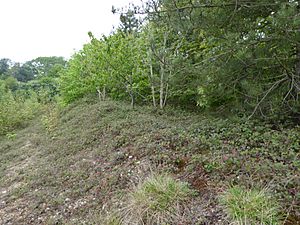Flixton Quarry facts for kids
| Site of Special Scientific Interest | |
 |
|
| Area of Search | Suffolk |
|---|---|
| Interest | Geological |
| Area | 0.7 hectares |
| Notification | 1991 |
| Location map | Magic Map |
Flixton Quarry is a special place in Suffolk, England. It's known as a Site of Special Scientific Interest (SSSI). This means it's protected because it has important natural features. Flixton Quarry is important for its geology, which is the study of Earth's rocks and history. It covers about 0.7 hectares (that's like a small park!). You can find it about 6 kilometers (3.75 miles) southwest of a town called Bungay.
Contents
What Makes Flixton Quarry Special?
Flixton Quarry is a very important site for understanding Earth's past. It helps scientists learn about ancient ice ages. The quarry has layers of sand and gravel. These layers were left behind by melting glaciers. This type of deposit is called a glacial outwash.
A Glimpse into the Ice Age
The sands and gravels at Flixton Quarry are very old. They formed during the Pleistocene epoch. This was a time when Earth experienced many ice ages. The deposits here date back to the Anglian glaciation. This was the most extreme ice age in Britain. It happened around 450,000 years ago. Imagine huge sheets of ice covering much of the land!
Why is This Site Important for Scientists?
Scientists from Natural England say Flixton Quarry is very important. It helps them understand what happened after the Anglian glaciation. The layers at Flixton Quarry show how the land changed. They connect to deposits from the Hoxnian Stage. This was a warmer period that came after the Anglian ice age. Studying these layers helps us piece together Earth's climate history.
Visiting Flixton Quarry
If you want to see Flixton Quarry, you can! There is a public footpath called the Angles Way. This path gives you access to the site. It's a great way to explore this unique natural area.

